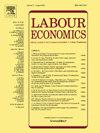Relaxation of fertility restrictions, sibling composition and gender gap in education: Evidence from China’s 1.5-child policy
IF 2.6
2区 经济学
Q2 ECONOMICS
引用次数: 0
Abstract
Fertility restrictions are generally believed to have increased children’s educational attainment. However, knowledge of the effects of relaxing fertility restrictions on the gender gap in education is lacking. Using China’s 1.5-child policy as an example, we explore how relaxing fertility restrictions affects the gender gap in education. We first construct a simple model to analyze how different family planning policies influence the gender gap in education through their effects on sibling composition. Using data from the 2010 China Family Panel Studies (CFPS), we next empirically estimate the policy effects through a triple-difference (DDD) approach. We find that the 1.5-child policy significantly widened the gender gap in education, primarily through a relative decline in female educational attainment compared to males. Heterogeneity analysis indicates that the eldest daughters, particularly those with younger brothers, experience a larger decline in educational attainment. We uncover two mechanisms limiting girls’ schooling: resource dilution through more siblings, and caregiving burdens as eldest sisters. We also find that supportive education policies can help narrow the gender gap in education by mitigating the negative impact on females’ educational attainment.
放宽生育限制、兄弟姐妹构成和教育中的性别差距:来自中国1.5胎政策的证据
人们普遍认为限制生育提高了儿童的受教育程度。但是,关于放宽生育限制对教育方面的性别差距的影响的知识缺乏。以中国的1.5孩政策为例,我们探讨了放宽生育限制如何影响教育中的性别差距。我们首先构建了一个简单的模型来分析不同的计划生育政策如何通过对兄弟姐妹构成的影响来影响教育中的性别差距。利用2010年中国家庭面板研究(CFPS)的数据,我们通过三差(DDD)方法对政策效果进行了实证估计。我们发现,1.5孩政策显著扩大了教育方面的性别差距,主要是通过女性受教育程度相对于男性的下降。异质性分析表明,大女儿,尤其是有弟弟的大女儿,受教育程度的下降幅度更大。我们发现了限制女孩上学的两种机制:通过更多的兄弟姐妹来稀释资源,以及作为大姐的照顾负担。我们还发现,支持性教育政策可以通过减轻对女性受教育程度的负面影响来帮助缩小教育中的性别差距。
本文章由计算机程序翻译,如有差异,请以英文原文为准。
求助全文
约1分钟内获得全文
求助全文
来源期刊

Labour Economics
ECONOMICS-
CiteScore
3.60
自引率
8.30%
发文量
142
期刊介绍:
Labour Economics is devoted to publishing research in the field of labour economics both on the microeconomic and on the macroeconomic level, in a balanced mix of theory, empirical testing and policy applications. It gives due recognition to analysis and explanation of institutional arrangements of national labour markets and the impact of these institutions on labour market outcomes.
 求助内容:
求助内容: 应助结果提醒方式:
应助结果提醒方式:


